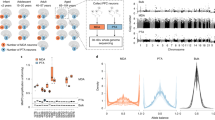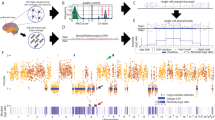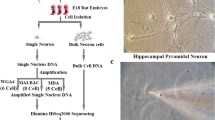Abstract
Recent studies of somatic mutation in neurons and other cell types suggest that somatic cells can acquire hundreds to thousands of new mutations over their lifetimes. Each individual mutation can have extremely low prevalence, with many mutations restricted to a single cell. Because of their rarity, somatic mutations can be challenging to detect and reliably distinguish from false-positive calls arising from amplification, sequencing, or bioinformatic methods. In these scenarios, a variety of methods are required to compensate for the limited applicability and technical artifacts inherent in any single approach. In the method we describe, somatic cell nuclear transfer (SCNT, also known as cloning) is used to reprogram single neurons to blastocysts from which we derive embryonic stem cells. Division of these cells faithfully amplifies the neuronal genome for next-generation sequencing and genome-wide mutation detection. This approach allows the detection of false positives due to amplification artifacts and is applicable to all classes of mutations. While it is both sensitive and reliable, our method is lower throughput than single-cell sequencing-based approaches and may also fail to amplify the most severely compromised neuronal genomes. In this chapter, we outline current methods for generating neuron-derived SCNT embryonic cell lines, discuss best practices for genome-wide mutation detection, and address the advantages and limitations of this approach.
Access this chapter
Tax calculation will be finalised at checkout
Purchases are for personal use only
Similar content being viewed by others
References
Rehen SK, McConnell MJ, Kaushal D, Kingsbury MA, Yang AH, Chun J (2001) Chromosomal variation in neurons of the developing and adult mammalian nervous system. Proc Natl Acad Sci 98(23):13361–13366
Muotri AR, Chu VT, Marchetto MCN, Deng W, Moran JV, Gage FH (2005) Somatic mosaicism in neuronal precursor cells mediated by L1 retrotransposition. Nature 435(7044):903–910
Rehen SK, Yung YC, McCreight MP, Kaushal D, Yang AH, Almeida BSV, Kingsbury MA, Cabral KMS, McConnell MJ, Anliker B, Fontanoz M, Chun J (2005) Constitutional aneuploidy in the normal human brain. J Neurosci 25(9):2176–2180
Coufal NG, Garcia-Perez JL, Peng GE, Yeo GW, Mu Y, Lovci MT, Morell M, O’Shea KS, Moran JV, Gage FH (2009) L1 retrotransposition in human neural progenitor cells. Nature 460(7259):1127–1131
Baillie JK, Barnett MW, Upton KR, Gerhardt DJ, Richmond TA, De Sapio F, Brennan PM, Rizzu P, Smith S, Fell M, Talbot RT, Gustincich S, Freeman TC, Mattick JS, Hume DA, Heutink P, Carninci P, Jeddeloh JA, Faulkner GJ (2011) Somatic retrotransposition alters the genetic landscape of the human brain. Nature 479(7374):534–537
Evrony GD, Cai X, Lee E, Hills LB, Elhosary PC, Lehmann HS, Parker JJ, Atabay KD, Gilmore EC, Poduri A, Park PJ, Walsh CA (2012) Single-neuron sequencing analysis of L1 Retrotransposition and somatic mutation in the human brain. Cell 151(3):483–496
Poduri A, Evrony Gilad D, Cai X, Elhosary Princess C, Beroukhim R, Lehtinen Maria K, Hills LB, Heinzen Erin L, Hill A, Hill RS, Barry Brenda J, Bourgeois Blaise FD, Riviello James J, Barkovich AJ, Black Peter M, Ligon Keith L, Walsh Christopher A (2012) Somatic activation of AKT3 causes hemispheric developmental brain malformations. Neuron 74(1):41–48. doi:10.1016/j.neuron.2012.03.010
McConnell MJ, Lindberg MR, Brennand KJ, Piper JC, Voet T, Cowing-Zitron C, Shumilina S, Lasken RS, Vermeesch JR, Hall IM, Gage FH (2013) Mosaic copy number variation in human neurons. Science 342(6158):632
Suberbielle E, Sanchez PE, Kravitz AV, Wang X, Ho K, Eilertson K, Devidze N, Kreitzer AC, Mucke L (2013) Physiologic brain activity causes DNA double-strand breaks in neurons, with exacerbation by amyloid-[beta]. Nat Neurosci 16(5):613–621. doi:10.1038/nn.3356; http://www.nature.com/neuro/journal/v16/n5/abs/nn.3356.html#supplementary-information
Gole J, Gore A, Richards A, Chiu Y-J, Fung H-L, Bushman D, Chiang H-I, Chun J, Lo Y-H, Zhang K (2013) Massively parallel polymerase cloning and genome sequencing of single cells using nanoliter microwells. Nat Biotechnol 31(12):1126–1132
Evrony Gilad D, Lee E, Mehta Bhaven K, Benjamini Y, Johnson Robert M, Cai X, Yang L, Haseley P, Lehmann Hillel S, Park Peter J, Walsh Christopher A (2014) Cell lineage analysis in human brain using endogenous Retroelements. Neuron 85(1):49–59. doi:10.1016/j.neuron.2014.12.028
Lodato MA, Woodworth MB, Lee S, Evrony GD, Mehta BK, Karger A, Lee S, Chittenden TW, D’Gama AM, Cai X, Luquette LJ, Lee E, Park PJ, Walsh CA (2015) Somatic mutation in single human neurons tracks developmental and transcriptional history. Science 350(6256):94
Upton Kyle R, Gerhardt Daniel J, Jesuadian JS, Richardson Sandra R, Sánchez-Luque Francisco J, Bodea Gabriela O, Ewing Adam D, Salvador-Palomeque C, van der Knaap MS, Brennan Paul M, Vanderver A, Faulkner Geoffrey J (2015) Ubiquitous L1 mosaicism in hippocampal neurons. Cell 161(2):228–239. doi:10.1016/j.cell.2015.03.026
Hazen Jennifer L, Faust Gregory G, Rodriguez Alberto R, Ferguson William C, Shumilina S, Clark Royden A, Boland Michael J, Martin G, Chubukov P, Tsunemoto Rachel K, Torkamani A, Kupriyanov S, Hall Ira M, Baldwin Kristin K (2016) The complete genome sequences, unique mutational spectra, and developmental potency of adult neurons revealed by cloning. Neuron 89(6):1223–1236. doi:10.1016/j.Neuron.2016.02.004
Erwin JA, Paquola ACM, Singer T, Gallina I, Novotny M, Quayle C, Bedrosian TA, Alves FIA, Butcher CR, Herdy JR, Sarkar A, Lasken RS, Muotri AR, Gage FH (2016) L1-associated genomic regions are deleted in somatic cells of the healthy human brain. Nat Neurosci 19(12):1583–1591. doi:10.1038/nn.4388; http://www.nature.com/neuro/journal/v19/n12/abs/nn.4388.html#supplementary-information
Cai X, Evrony Gilad D, Lehmann Hillel S, Elhosary Princess C, Mehta Bhaven K, Poduri A, Walsh Christopher A (2014) Single-cell, genome-wide sequencing identifies clonal somatic copy-number variation in the human brain. Cell Rep 8(5):1280–1289. doi:10.1016/j.celrep.2014.07.043
Lathe R, Harris A (2009) Differential display detects host nucleic acid motifs altered in scrapie-infected brain. J Mol Biol 392(3):813–822. doi:10.1016/j.jmb.2009.07.045
Jeong B-H, Lee Y-J, Carp RI, Kim Y-S (2010) The prevalence of human endogenous retroviruses in cerebrospinal fluids from patients with sporadic Creutzfeldt–Jakob disease. J Clin Virol 47(2):136–142
Muotri AR, Marchetto MC, Coufal NG, Oefner R, Yeo G, Nakashima K, Gage FH (2010) L1 retrotransposition in neurons is modulated by MeCP2. Nature 468(7322):443–446
Douville R, Liu J, Rothstein J, Nath A (2011) Identification of active loci of a human endogenous retrovirus in neurons of patients with amyotrophic lateral sclerosis. Ann Neurol 69(1):141–151. doi:10.1002/ana.22149
Kaneko H, Dridi S, Tarallo V, Gelfand BD, Fowler BJ, Cho WG, Kleinman ME, Ponicsan SL, Hauswirth WW, Chiodo VA, Kariko K, Yoo JW, D-k L, Hadziahmetovic M, Song Y, Misra S, Chaudhuri G, Buaas FW, Braun RE, Hinton DR, Zhang Q, Grossniklaus HE, Provis JM, Madigan MC, Milam AH, Justice NL, Albuquerque RJC, Blandford AD, Bogdanovich S, Hirano Y, Witta J, Fuchs E, Littman DR, Ambati BK, Rudin CM, Chong MMW, Provost P, Kugel JF, Goodrich JA, Dunaief JL, Baffi JZ, Ambati J (2011) DICER1 deficit induces Alu RNA toxicity in age-related macular degeneration. Nature 471(7338):325–330
Coufal NG, Garcia-Perez JL, Peng GE, Marchetto MCN, Muotri AR, Mu Y, Carson CT, Macia A, Moran JV, Gage FH (2011) Ataxia telangiectasia mutated (ATM) modulates long interspersed element-1 (L1) retrotransposition in human neural stem cells. Proc Natl Acad Sci 108(51):20382–20387
Tan H, Qurashi A, Poidevin M, Nelson DL, Li H, Jin P (2012) Retrotransposon activation contributes to fragile X premutation rCGG-mediated neurodegeneration. Hum Mol Genet 21(1):57–65
Li W, Jin Y, Prazak L, Hammell M, Dubnau J (2012) Transposable elements in TDP-43-mediated neurodegenerative disorders. PLoS One 7(9):e44099. doi:10.1371/journal.pone.0044099
Li W, Prazak L, Chatterjee N, Gruninger S, Krug L, Theodorou D, Dubnau J (2013) Activation of transposable elements during aging and neuronal decline in drosophila. Nat Neurosci 16(5):529–531
Bundo M, Toyoshima M, Okada Y, Akamatsu W, Ueda J, Nemoto-Miyauchi T, Sunaga F, Toritsuka M, Ikawa D, Kakita A, Kato M, Kasai K, Kishimoto T, Nawa H, Okano H, Yoshikawa T, Kato T, Iwamoto K (2014) Increased L1 Retrotransposition in the neuronal genome in schizophrenia. Neuron 81(2):306–313. doi:10.1016/j.neuron.2013.10.053
Borgesius NZ, de Waard MC, van der Pluijm I, Omrani A, Zondag GCM, van der Horst GTJ, Melton DW, Hoeijmakers JHJ, Jaarsma D, Elgersma Y (2011) Accelerated age-related cognitive decline and neurodegeneration, caused by deficient DNA repair. J Neurosci 31(35):12543
Madabhushi R, Pan L, Tsai L-H (2014) DNA damage and its links to neurodegeneration. Neuron 83(2):266–282. doi:10.1016/j.neuron.2014.06.034
Jeppesen DK, Bohr VA, Stevnsner T (2011) DNA repair deficiency in neurodegeneration. Prog Neurobiol 94(2):166–200. doi:10.1016/j.pneurobio.2011.04.013
Poduri A, Evrony GD, Cai X, Walsh CA (2013) Somatic mutation, genomic variation, and neurological disease. Science 341(6141):1237758
Shendure J, Akey JM (2015) The origins, determinants, and consequences of human mutations. Science 349(6255):1478–1483
McKinnon PJ (2013) Maintaining genome stability in the nervous system. Nat Neurosci 16(11):1523–1529. doi:10.1038/nn.3537
Gawad C, Koh W, Quake SR (2016) Single-cell genome sequencing: current state of the science. Nat Rev Genet 17(3):175–188. doi:10.1038/nrg.2015.16
Macaulay IC, Voet T (2014) Single cell genomics: advances and future perspectives. PLoS Genet 10(1):e1004126. doi:10.1371/journal.pgen.1004126
Herrup K, Neve R, Ackerman SL, Copani A (2004) Divide and die: cell cycle events as triggers of nerve cell death. J Neurosci 24(42):9232
Hiler D, Chen X, Hazen J, Kupriyanov S, Carroll Patrick A, Qu C, Xu B, Johnson D, Griffiths L, Frase S, Rodriguez Alberto R, Martin G, Zhang J, Jeon J, Fan Y, Finkelstein D, Eisenman Robert N, Baldwin K, Dyer Michael A (2015) Quantification of Retinogenesis in 3D cultures reveals epigenetic memory and higher efficiency in iPSCs derived from rod photoreceptors. Cell Stem Cell 17(1):101–115. doi:10.1016/j.stem.2015.05.015
Ajioka I, Martins RAP, Bayazitov IT, Donovan S, Johnson DA, Frase S, Cicero SA, Boyd K, Zakharenko SS, Dyer MA (2007) Differentiated horizontal interneurons clonally expand to form metastatic retinoblastoma in mice. Cell 131(2):378–390. doi:10.1016/j.cell.2007.09.036
Friedmann-Morvinski D, Bushong EA, Ke E, Soda Y, Marumoto T, Singer O, Ellisman MH, Verma IM (2012) Dedifferentiation of neurons and astrocytes by oncogenes can induce gliomas in mice. Science 338(6110):1080–1084
Kim J, Lengner CJ, Kirak O, Hanna J, Cassady JP, Lodato MA, Wu S, Faddah DA, Steine EJ, Gao Q, Fu D, Dawlaty M, Jaenisch R (2011) Reprogramming of postnatal neurons into induced pluripotent stem cells by defined factors. Stem Cells 29(6):992–1000
Wilmut I, Schnieke AE, McWhir J, Kind AJ, Campbell KHS (1997) Viable offspring derived from fetal and adult mammalian cells. Nature 385(6619):810–813
Wakayama T, Perry ACF, Zuccotti M, Johnson KR, Yanagimachi R (1998) Full-term development of mice from enucleated oocytes injected with cumulus cell nuclei. Nature 394(6691):369–374
Eggan K, Baldwin K, Tackett M, Osborne J, Gogos J, Chess A, Axel R, Jaenisch R (2004) Mice cloned from olfactory sensory neurons. Nature 428(6978):44–49
Eggan K, Jaenisch R (2006) Generation of embryonic stem (ES) cell-derived embryos and mice by tetraploid–embryo complementation. Mammalian and avian Transgenesis—new approaches. Springer, Heidelberg
Hochedlinger K, Jaenisch R (2002) Monoclonal mice generated by nuclear transfer from mature B and T donor cells. Nature 415(6875):1035–1038
Makino H, Yamazaki Y, Hirabayashi T, Kaneko R, Hamada S, Kawamura Y, Osada T, Yanagimachi R, Yagi T (2005) Mouse embryos and chimera cloned from neural cells in the postnatal cerebral cortex. Cloning Stem Cells 7(1):45–61
Nagy A, Gocza E, Diaz EM, Prideaux VR, Ivanyi E, Markkula M, Rossant J (1990) Embryonic stem cells alone are able to support fetal development in the mouse. Development 110(3):815–821
Nagy A, Rossant J, Nagy R, Abramow-Newerly W, Roder JC (1993) Derivation of completely cell culture-derived mice from early-passage embryonic stem cells. Proc Natl Acad Sci 90(18):8424–8428
Tachibana M, Amato P, Sparman M, Gutierrez Nuria M, Tippner-Hedges R, Ma H, Kang E, Fulati A, Lee H-S, Sritanaudomchai H, Masterson K, Larson J, Eaton D, Sadler-Fredd K, Battaglia D, Lee D, Wu D, Jensen J, Patton P, Gokhale S, Stouffer Richard L, Wolf D, Mitalipov S (2013) Human embryonic stem cells derived by somatic cell nuclear transfer. Cell 153(6):1228–1238. doi:10.1016/j.cell.2013.05.006
Lewandoski M (2001) Conditional control of gene expression in the mouse. Nat Rev Genet 2(10):743–755
Madisen L, Zwingman TA, Sunkin SM, SW O, Zariwala HA, Gu H, Ng LL, Palmiter RD, Hawrylycz MJ, Jones AR, Lein ES, Zeng H (2010) A robust and high-throughput Cre reporting and characterization system for the whole mouse brain. Nat Neurosci 13(1):133–140; http://www.nature.com/neuro/journal/v13/n1/suppinfo/nn.2467_S1.html
Brewer GJ, Torricelli JR (2007) Isolation and culture of adult neurons and neurospheres. Nat Protoc 2(6):1490–1498
Kishigami S, Wakayama S, Van Thuan N, Ohta H, Mizutani E, Hikichi T, Bui H-T, Balbach S, Ogura A, Boiani M, Wakayama T (2006) Production of cloned mice by somatic cellnuclear transfer. Nat Protoc 1(1):125–138; http://www.nature.com/nprot/journal/v1/n1/suppinfo/nprot.2006.21_S1.html
Eggan K, Jaenisch R (2006) Cloning the laboratory mouse by nuclear transfer. In: Pease S, Lois C (eds) Mammalian and Avian transgenesis—new approaches. Springer, Berlin, pp 69–96. doi:10.1007/978-3-540-28489-5_4
Kishigami S, Mizutani E, Ohta H, Hikichi T, Thuan NV, Wakayama S, Bui H-T, Wakayama T (2006) Significant improvement of mouse cloning technique by treatment with trichostatin a after somatic nuclear transfer. Biochem Biophys Res Commun 340(1):183–189. doi:10.1016/j.bbrc.2005.11.164
Meissner A, Eminli S, Jaenisch R (2009) Derivation and manipulation of murine embryonic stem cells. In: Audet J, Stanford W (eds) Stem cells in regenerative medicine, Methods in molecular biology, vol 482. Humana Press, New York, pp 3–19. doi:10.1007/978-1-59745-060-7_1
Tamm C, Pijuan Galitó S, Annerén C (2013) A comparative study of Protocols for mouse embryonic stem cell culturing. PLoS One 8(12):e81156. doi:10.1371/journal.pone.0081156
Chiang C, Layer RM, Faust GG, Lindberg MR, Rose DB, Garrison EP, Marth GT, Quinlan AR, Hall IM (2015) SpeedSeq: ultra-fast personal genome analysis and interpretation. Nat Methods 12:966–968. doi:10.1038/nmeth.3505
Tarasov A, Vilella AJ, Cuppen E, Nijman IJ, Prins P (2015) Sambamba: fast processing of NGS alignment formats. Bioinformatics 31:2032–2034. doi:10.1093/bioinformatics/btv098
DePristo M, Banks E, Poplin R, Garimella K, Maguire J, Hartl C, Philippakis A, del Angel G, Rivas MA, Hanna M, McKenna A, Fennell T, Kernytsky A, Sivachenko A, Cibulskis K, Gabriel S, Altshuler D, Daly M (2011) A framework for variation discovery and genotyping using next-generation DNA sequencing data. Nature Genetics 43:491–498. doi:10.1038/ng.806
Van der Auwera GA, Carneiro MO, Hartl C, Poplin R, Del Angel G, Levy-Moonshine A, Jordan T, Shakir K, Roazen D, Thibault J, Banks E, Garimella KV, Altshuler D, Gabriel S, DePristo MA (2013) From FastQ data to high confidence variant calls: the genome analysis toolkit best practices pipeline. Curr Protoc Bioinformatics 43:11.10–11.33. doi:10.1002/0471250953.bi1110s43
Keane TM, Goodstadt L, Danecek P, White MA, Wong K, Yalcin B, Heger A, Agam A, Slater G, Goodson M, Furlotte NA, Eskin E, Nellåker C, Whitley H, Cleak J, Janowitz D, Hernandez-Pliego P, Edwards A, Belgard TG, Oliver PL, McIntyre RE, Bhomra A, Nicod J, Gan X, Yuan W, van der Weyden L, Steward CA, Balasubramaniam S, Stalker J, Mott R, Durbin R, Jackson IJ, Czechanski A, Assunção JAG, Donahue LR, Reinholdt LG, Payseur BA, Ponting CP, Birney E, Flint J, Adams DJ (2011) Mouse genomic variation and its effect on phenotypes and gene regulation. Nature 477:289–294. doi:10.1038/nature10413
Kong A, Frigge ML, Masson G, Besenbacher S, Sulem P, Magnusson G, Gudjonsson SA, Sigurdsson A, Jonasdottir A, Jonasdottir A, Wong WSW, Sigurdsson G, Walters GB, Steinberg S, Helgason H, Thorleifsson G, Gudbjartsson DF, Helgason A, Magnusson OT, Thorsteinsdottir U, Stefansson K (2012) Rate of de novo mutations and the importance of father/’s age to disease risk. Nature 488:471–475. doi:10.1038/nature11396
Layer RM, Chiang C, Quinlan AR, Hall IM (2014) LUMPY: a probabilistic framework for structural variant discovery. Genome Biol 15:R84. doi:10.1186/gb-2014-15-6-r84
Hall IM, et. al., SV Typer. https://github.com/hall-lab/sv-pipeline
Derrien T, Estellé J, Sola SM, Knowles DG, Raineri E, Guigó R, Ribeca P (2012) Fast computation and applications of genome Mappability. PLoS One 7:e30377. doi:10.1371/journal.pone.0030377
Author information
Authors and Affiliations
Corresponding author
Editor information
Editors and Affiliations
Rights and permissions
Copyright information
© 2017 Springer Science+Business Media LLC
About this protocol
Cite this protocol
Hazen, J.L. et al. (2017). Using Cloning to Amplify Neuronal Genomes for Whole-Genome Sequencing and Comprehensive Mutation Detection and Validation. In: Frade, J., Gage, F. (eds) Genomic Mosaicism in Neurons and Other Cell Types. Neuromethods, vol 131. Humana Press, New York, NY. https://doi.org/10.1007/978-1-4939-7280-7_9
Download citation
DOI: https://doi.org/10.1007/978-1-4939-7280-7_9
Published:
Publisher Name: Humana Press, New York, NY
Print ISBN: 978-1-4939-7279-1
Online ISBN: 978-1-4939-7280-7
eBook Packages: Springer Protocols




